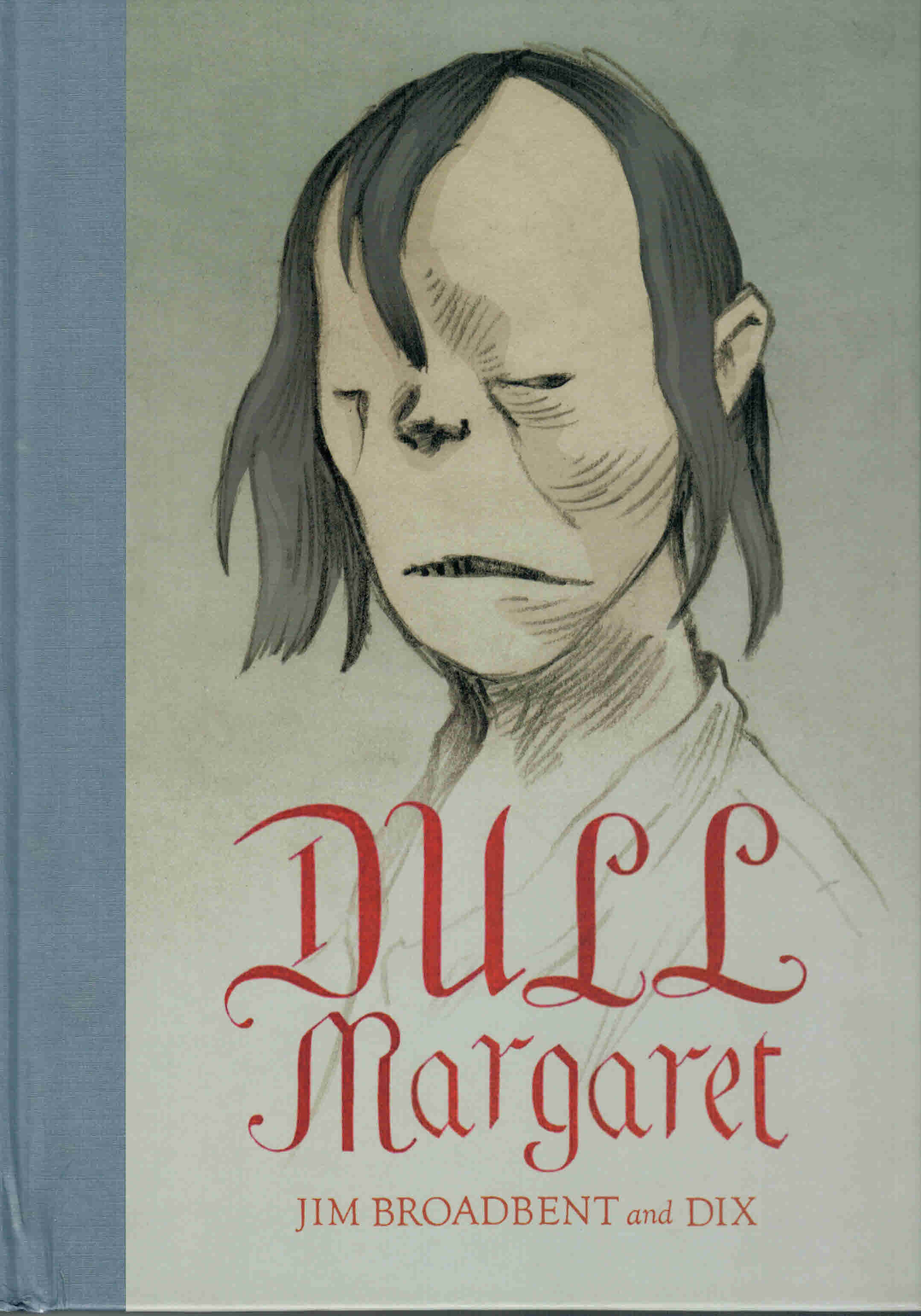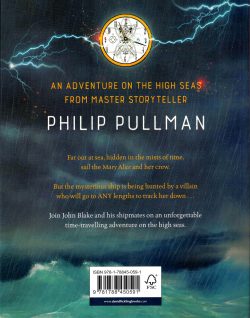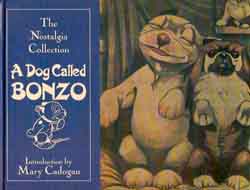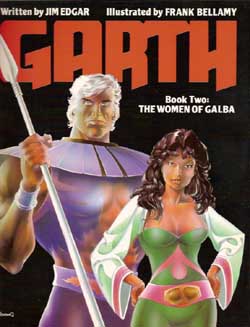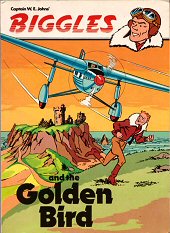
By Björn Karlström, translated by Peter James (Hodder and Stoughton)
ISBN: 978-0-34023-081-7(HB)Â Â Â Â Â Â Â Â Â Â Â Â Â Â Â Â Â Â Â Â Â 0-340-23081-9(PB)
In acknowledgement of today’s Centenary of the Royal Air Force, I’m reviewing a captivating combat classic starring one of the Service’s most glittering – albeit fictional – stars.
Although one of the most popular and enduring of all True Brit heroes, air detective Squadron Leader James Bigglesworth – immortally known as “Biggles†– has never been the star of British comics you’d reasonably expect.
Whilst the likes of Sherlock Holmes, Dick Turpin, Sexton Blake, Dick Barton and others have regularly made the jump to sequential pictorials, as far as I can determine the only time Biggles hit the funny pages was as a beautiful strip illustrated firstly by Ron Embleton and later Mike Western for the lush, tabloid-sized photogravure weekly TV Express (issues 306-376, 1960-1962). Even then the strip was based on the 1960 television series rather than the armada of books and short stories generated over Johns’ 56-year career.
Much of this superb stuff has been reprinted in French and other European editions but remains criminally uncollected in the UK. Indeed Biggles is huge all over the Continent, particularly Holland, Belgium and France, which makes it doubly galling that only a short-lived Swedish interpretation of Biggles has ever made the transition back to Blighty…
Created by World War 1 flying veteran and aviation enthusiast William Earl Johns (February 5th 1893-June 21st 1968), the airborne adventures of Biggles, his cousin the Hon. Algernon Montgomery Lacey AKA “Algyâ€, Ginger Hebblethwaite and their trusty mechanic and dogsbody Flight Sergeant Smyth ran as prose thrillers in the magazines Modern Boy, Popular Flying and Flying – periodicals which Johns designed, edited and even illustrated.
Initially aimed at an older audience, the Biggles stories quickly became a staple of boys’ entertainment in anthology and full novels (nearly 100 between 1932-1968) as well as a true cultural icon. Utilising the unique timeless quality of proper heroes, Biggles and Co. have waged their dauntless war against evil as combatants in World Wars I and II, as Special Air Detectives for Scotland Yard in the interregnum of 1918-1939 and as freelance agents and adventurers in the Cold War years…
“Captain†W.E. Johns was one of the most prolific writers of the 20th century and wrote over 160 books in total as well as innumerable features and articles ranging from gardening to treasure-hunting, aviation, crime fiction, pirates and historical fact and fiction.
He created many heroic novel series which shared the same continuity as Biggles: 6 “Steeley†novels starring Deeley Montfort Delaroy, a WWI fighter ace-turned-crimebuster between 1936-1939, 10 volumes of commando Captain Lorrington King AKA Gimlet (1943-1954) and a 10 volume science fiction saga starring retired RAF Group Captain Timothy ‘Tiger’ Clinton, his son Rex and boffin Professor Lucius Brane who voyaged among the stars in a cosmic ray powered spaceship between 1954 and 1963.
Although much of his work is afflicted with the parochial British jingoism and racial superiority that blights so much of the fiction of the early 20th century, Johns was certainly ahead of his time in areas of class and gender equality. Although Algy is a purely traditional plucky Toff, working class Ginger is an equal partner and participant in all things, whilst Flight Officer Joan Worralson was a WAAF pilot who starred in 11 “Worrals†novels between 1941 and 1950, commissioned by the Air Ministry to encourage women to enlist in the Women’s Auxiliary Air Force.
In 1977, veteran Swedish author and cartoonist Björn Karlström returned to comics when publisher Semics commissioned him to produce four new Biggles adventures; ‘Het Sargasso mysterie’, ‘Operatie goudvis’, ‘De tijger bende’ and ‘Ruimtestation Aries’ (The Sargasso Mystery; Operation Goldfish; The Tiger Gang and Space Station Aries, respectively). These were picked up by Hodder and Stoughton in 1978, deftly translated by Peter James and released as Biggles and the Sargasso Triangle, Biggles and the Golden Bird, Biggles and the Tiger and Biggles and the Menace from Space…
In 1983, two further albums were released, created by Stig Stjernvik.
Although deeply mired in the stylisation and tone of Hergé’s Tintin, to my mind the most authentic-seeming to Johns’ core concept was the second, highlighted here for today’s celebrations…
Swedish designer, author and aviation enthusiast Björn Karlström began working in comics for the vast Scandinavian market in 1938, producing scale-model plans and drawings for the magazine Flygning. In 1941 he created the adventure strip Jan Winther for them before devising international speculative fiction hit Johnny Wiking: followed up with another SF classic which closely foreshadowed the microscopic missionaries of (Otto Klement, Jerome Bixby and Isaac Asimov’s) Fantastic Voyage in ‘En Resa i Människokroppen’ (1943-1946), before taking over Lennart Ek’s successful super-heroine strip Dotty Virvelvind in 1944.
Karlström left comics at the end of the war and returned to illustration and commercial design, working on jet fighters for Saab and trucks for Scania.
Whereas most of his earlier comics were rendered in a passable imitation of Alex Raymond’s Flash Gordon, when he was convinced to produce the Biggles quartet Karlström adopted a raw, lean version of Hergé’s Ligne Claire style which adds a welcome sense of period veracity to the tales but often offends and upsets Tintin purists…
Biggles and the Golden Bird is set in the early 1930s and begins when the aerial adventurers are asked to pilot a new super-plane in an attempt to break the world long-distance flying record. Fact freaks might be intrigued to discover that the “Fairview†of this story is closely based on the record-smashing Fairey Long Range Monoplane, which stars in a splendid plans-&-diagrams section at the back that also includes the De Havilland C-24 Autogiro also featuring prominently in this ripping yarn…
When mysterious intruders brazenly steal the Fairview, intelligence supremo General Raymond dispatches Biggles, Algy and Ginger to track them down and retrieve the prototype air-machine. A crashed light plane and a rustic witness point the trio in the direction of Scotland and, dashing North in a ministry-provided autogiro (that’s a cross between a plane and an early kind of helicopter), they rendezvous with a fishing boat whose captain also witnessed strange sky shenanigans only to be attacked and overcome…
Their enigmatic adversaries had anticipated the pursuit and laid a trap, but with a typical display of pluck and fortune, Ginger turns the tables and drives off the thugs. The real Captain Gilbert then imparts his information and the autogiro brings them to a desolate ruined castle on a rocky headland, where Ginger and Algy are captured by an armed gang even as poor Biggles plunges over a cliff to certain doom…
Naturally the Ace Aviator saves himself at the last moment and subsequently discovers a sub-sea cavern – complete with deep-sea diving operation – just as his pals cunningly escape captivity. Fortuitously meeting up, the trio follow their foes and find a sunken U-Boat full of gold…
The uncanny reason for the theft of the Fairview and the mastermind behind it all is revealed when arch-enemy and all-around Hunnish blackguard Erich von Stalhein arrives to take possession of the recovered bullion before fleeing to a new life in distant lands. Having none of it the plucky lads strike, leading to a blistering battle and spectacular showdown…
Fast and furious, full of fights and hairsbreadth chases – although perhaps a touch formulaic and too steeped in the old-fashioned traditions for modern comics purists – this light and snappy tale would delight newer readers and general action fans and is readily available in both hardback and softcover editions, since the books were re-released in 1983 in advance of the star-studded but controversial British film-flop Biggles: Adventures in Time.
Perhaps it’s time for another revival and even some fresh exploits?
Characters © W.E. Johns (Publications). Text and pictures © 1978 Björn Karlström. English text © 1978 Hodder and Stoughton Ltd.
